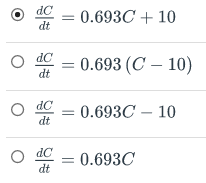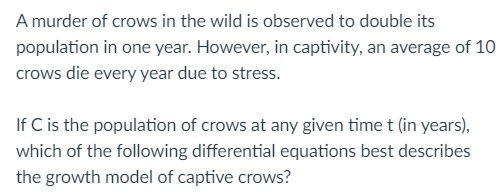A murder of crows in the wild is observed to double its population in one year. However, in captivity, an average of 10 crows die every year due to stress. If C is the population of crows at any given time t (in years), which of the following differential equations best describes the growth model of captive crows?
A murder of crows in the wild is observed to double its population in one year. However, in captivity, an average of 10 crows die every year due to stress. If C is the population of crows at any given time t (in years), which of the following differential equations best describes the growth model of captive crows?
Algebra & Trigonometry with Analytic Geometry
13th Edition
ISBN:9781133382119
Author:Swokowski
Publisher:Swokowski
Chapter5: Inverse, Exponential, And Logarithmic Functions
Section5.4: Logarithmic Functions
Problem 17E
Related questions
Question
Please show solution.

Transcribed Image Text:dC
0.693C + 10
dt
O dC
0.693 (C – 10)
dt
O dC
= 0.693C – 10
dt
O dC
= 0.693C
dt

Transcribed Image Text:A murder of crows in the wild is observed to double its
population in one year. However, in captivity, an average of 10
crows die every year due to stress.
If C is the population of crows at any given time t (in years),
which of the following differential equations best describes
the growth model of captive crows?
Expert Solution
This question has been solved!
Explore an expertly crafted, step-by-step solution for a thorough understanding of key concepts.
Step by step
Solved in 2 steps with 2 images

Recommended textbooks for you

Algebra & Trigonometry with Analytic Geometry
Algebra
ISBN:
9781133382119
Author:
Swokowski
Publisher:
Cengage

Algebra & Trigonometry with Analytic Geometry
Algebra
ISBN:
9781133382119
Author:
Swokowski
Publisher:
Cengage